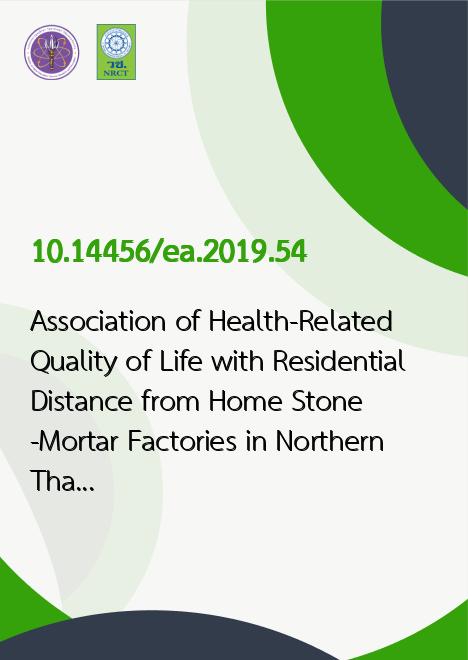
|
Association of Health-Related Quality of Life with Residential Distance from Home Stone-Mortar Factories in Northern Thailand |
|---|---|
| รหัสดีโอไอ | |
| Creator | 1. Sakesun Thongtip 2. Penprapa Siviroj 3. Athavudh Deesomchok 4. Anawat Wisetborisut 5. Tippawan Prapamontol |
| Title | Association of Health-Related Quality of Life with Residential Distance from Home Stone-Mortar Factories in Northern Thailand |
| Publisher | Thai Society of Higher Education Institutes on Environment |
| Publication Year | 2562 |
| Journal Title | EnvironmentAsia |
| Journal Vol. | 12 |
| Journal No. | 3 |
| Page no. | 140-150 |
| Keyword | HRQOL, Respiratory symptoms, Stone-mortar, PM10, Crystalline silica, GIS |
| URL Website | http://www.tshe.org/ea/index.html |
| Website title | EnvironmentAsia |
| ISSN | 1906-1714 |
| Abstract | Particulate matter less than 10 ตm in diameter (PM10) from home industry has a huge impact on the environment, adversely affecting respiratory symptoms and quality of life. We aimed to assess the health-related quality of life (HRQOL), respiratory symptoms and residential distance. A crosssectional study was carried out with 380 subjects who were interviewed using the SF-36 Quality of Life Instrument, respiratory symptoms also being assessed. Residential distance was measured using a geographic information system (GIS) tool. PM10 and crystalline silica concentrations were measured by 41 samplers from 11 stone-mortar factories. The results showed that the average PM10 and silica concentrations were lower than recommendations by NIOSH and ACGIH, while the crystalline silica concentrations were higher. The average scores of the physical components HRQOL were higher than those of a control group of Thai volunteers. The overall HRQOL findings were significantly different in age, income, education, occupation, respiratory symptoms, underlying diseases and residential distance. The multivariable analysis indicated that residential distance was associated with physical, mental and overall HRQOL after adjusting for age, respiratory symptoms and underlying diseases. Therefore, the local policy makers need to facilitate the reduction in air pollution from stone factories to improve respiratory health and quality of life. |